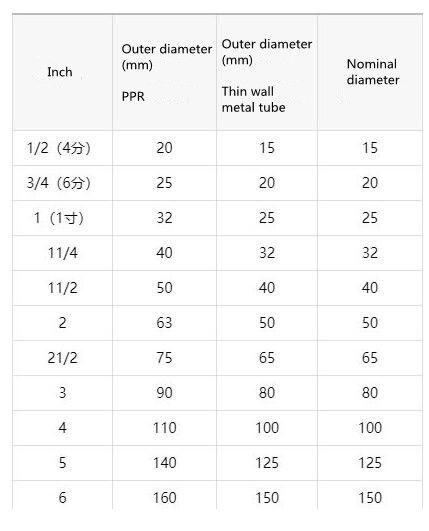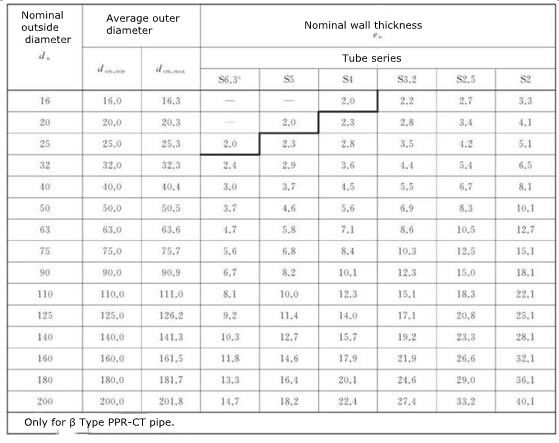Pipe is the material used to make pipe fittings. Different pipes should be used for different pipe fittings, and the quality of pipe directly determines the quality of pipe fittings. This kind of pipe is widely used in construction engineering, power plant and chemical plant. The Pipes are including: PPR pipe, PVC pipe, UPVC pipe, copper pipe, steel pipe, fiber pipe, composite pipe, galvanized pipe, hose, reducer, water pipe. There are executive standards GB / t5310 for high-pressure boilers. There are executive standards GB / t8163, seamless steel pipes for fluid transmission. There are executive standards GB3087, seamless steel pipes for low-pressure boilers. There are executive standards GB / t9948, seamless steel pipes for petroleum cracking. There are executive standards GB / t14976, seamless stainless steel pipes for fluid transmission, who's common materials are alloy (15CrMo, 12Cr1MoV) carbon steel (10 #, 20 #, 20 #, 20 # 45) stainless steel (304, 316).

The specification of water pipe is a seemingly simple problem, but not everyone can make it clear. Because there are different types of pipes in the water pipe industry, and the characteristics of various pipes are different, the meanings of the specifications and parameters describing them are also different. The specification parameters of PPR pipe are mainly pipe diameter and wall thickness. Let's discuss it.
1. Pipe Diameter Specification
First of all, we introduce three concepts - the nominal diameter of the pipe Φ,Nominal diameter DN and English units.
The nominal outer diameter of the pipe is the outer diameter of the pipe, which is usually indicated by "DN". What is the following numbers marked on the pipe Φ.
The nominal diameter DN is the average outer diameter of the pipeline. It is generally a round integer, a reference value, which is different from the actual pipeline size.
British unit refers to the four and six points tube and one inch tube. The nominal diameter comes from the thin wall thickness of the metal pipe. So the average diameter of the outer diameter and inner diameter is almost equal to the outer diameter, i.e. DN= Φ。 But for PPR pipe, due to the thick wall, the difference between the nominal outer diameter DN and the actual outer diameter of the pipe is relatively large, so it needs to be distinguished. In PPR water pipes, the relationship among English units, nominal diameter and actual outer diameter is as follow.

In the home decoration pipeline, the common outer diameter specifications of PPR pipe are 20 mm, 25 mm and 32 mm.
2. Tube series: S
There are two parameters for the wall thickness property of PPR pipe. Pipe series S is one of them.
By definition, pipe series S is a dimensionless number related to nominal outer diameter and nominal wall thickness, which is used to guide the selection of pipe specifications. It is a set of round integers obtained after calculation.

Pipe series S can be calculated by the above formula
• DN -- Nominal outer diameter of pipe, unit: mm;
• EN -- PPR nominal wall thickness, unit: mm;
In "GB / T 18742.2-2017 polypropylene piping systems for hot and cold water part 2: pipes" the specific specifications and parameters of pipe series S are as shown in the table below:

When the nominal outer diameter of PPR pipe is fixed, the pipe series S is larger, the wall thickness of water pipe is thinner. The smaller the pipe series S is smaller, the wall thickness of water pipe is thicker.
3. Standard Dimension Ratio: SDR
Standard dimension ratio is another parameter related to wall thickness of PPR pipe. PPR pipe can be divided into five series according to SDR value: SDR 11, SDR9, SDR 7.4, SDR 6 and SDR 5.

SDR is the ratio of nominal outer diameter to nominal wall thickness of PPR pipe. The relationship between SDR and PPR tube series s is: SDR = 2S + 1.
The same as the pipe series S. When the nominal outer diameter of PPR pipe is certain, the larger the standard size is than SDR, the thinner the wall thickness of water pipe, and the smaller the standard size is than SDR, the thicker the wall thickness of water pipe.
4. Specification of PPR Pipe Fittings
The nominal outer diameter DN of PPR pipe fittings is consistent with the nominal outer diameter of the PPR pipe connected with it. And it is often marked on the PPR pipe fittings.
The wall thickness of PPR pipe fittings shall not be less than that of PPR pipes of the same PPR pipe series S. Most enterprises PPR pipe fittings only have the highest standard S2 series, which is applicable to all cold and hot water.
For pipe fittings with thread(threaded parts), there are two kinds of thread specifications, 1 / 2 and 3 / 4. What is the difference between 4 points and 6 points. The corresponding nominal diameters of thread are 15mm and 20mm respectively.
How to Calculate The Weight of One Meter PE Pipe?
You might get a lot answer from the customers that ask you how much a kilogram of the PE Pipe. Here we need to use a data "meter weight" - the weight of one meter.
Meter weight (kg / M) = (outer diameter - wall thickness) _ wall thickness _ 3.14 * 1.05/1000
How to Calculate The Specification And Price of Hot Melt PE Pipe?
The specification of PE pipe is generally calculated by nominal outer diameter. And the valve or steel pipe of iron parts are calculated by the internal diameter.
For example, the pipe with an outer diameter of 63mm is as same as the specification of the steel pipe with 50mm.
As for price, the formula of meter weight (the weight of one meter) of pipe is generally calculated first.
(outer diameter * wall thickness *3.14) ÷ 1000= meter weight
After calculating the meter weight, we need to know what the current raw material price is. For example, the price of raw materials is $2000 per ton, plus the processing cost of pipe is $300 per ton.
Then the price of one meter's PE pipe is meter weight* ($2000+$300)/1000